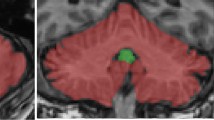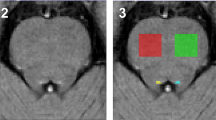Abstract
Purpose
The purpose of this study was to examine the relationship between the volume and number of tubers and the age at seizure onset in patients with tuberous sclerosis complex. We also examined the relationship between the volume and number of cyst-like tubers and the age at seizure onset.
Materials and methods
We retrospectively studied 23 patients with TSC (16 males and 7 females, mean age 12.4 ± 9.5 years). Routine structural MR-imaging data analysis was performed using QBrain. Total brain volume, total tuber volume, and the number of tubers were measured semi-automatically. Additionally, the total volume and the number of only cyst-like tubers were measured. The tuber/brain proportion (TBP) and the cyst-like tuber/brain proportion (cTBP) were calculated, and these were compared with the age at seizure onset. The numbers of tubers and cyst-like tubers were also compared with the age at seizure onset.
Results
For both TBP and the number of tubers, a significant negative correlation with age at seizure onset was identified (ρ = −0.69, p < 0.01 and ρ = −0.56, p < 0.01). No significant correlation of cTBP or the number of cyst-like tubers with age at seizure onset was identified (ρ = −0.26, p = 0.37 and ρ = −0.048, p = 0.87).
Conclusion
TBP may be associated with age at seizure onset.






Similar content being viewed by others
References
Sancak O, Nellist M, Goedbloed M, Elfferich P, Wouters C, Maat-Kievit A, et al. Mutational analysis of the TSC1 and TSC2 genes in a diagnostic setting: genotype-phenotype correlations and comparison of diagnostic DNA techniques in tuberous sclerosis complex. Eur J Hum Genet. 2005;13:731–41.
Dabora SL, Jozwiak S, Franz DN, Roberts PS, Nieto A, Chung J, et al. Mutational analysis in a cohort of 224 tuberous sclerosis patients indicates increased severity of TSC2, compared with TSC1, disease in multiple organs. Am J Hum Genet. 2001;68:64–80.
Crino PB, Nathanson KL, Henske EP. The tuberous sclerosis complex. N Engl J Med. 2006;355:1345–56.
Thiele EA. Managing epilepsy in tuberous sclerosis complex. J Child Neurol. 2004;19:680–6.
Webb DW, Fryer AE, Osborned JP. Morbidity associated with tuberous sclerosis: a population study. Dev Med Child Neurol. 1996;38:146–55.
Curatolo P, Verdecchia M, Bombardieri R. Tuberous sclerosis complex: a review of neurological aspects. Eur J Paediatr Neurol. 2002;6:15–23.
Goh S, Kwiatkowski DJ, Dorer DJ, Thiele EA. Infantile spasms and intellectual outcomes in children with tuberous sclerosis complex. Neurology. 2005;65:235–8.
Jansen FE, Vincken KL, Algra A, Anbeek P, Braams O, Nellist M, et al. Cognitive impairment in tuberous sclerosis complex is a multifactorial condition. Neurology. 2008;70:916–23.
O’Callaghan FJ, Harris T, Joinson C, Bolton P, Noakes M, Presdee D, et al. The relation of infantile spasms, tubers, and intelligence in tuberous sclerosis complex. Arch Dis Child. 2004;89:530–3.
Mamdani EH, Assilian S. An experiment in linguistic synthesis with a fuzzy logic controller. Int J Man Mach Stud. 1975;7:1–13.
Kaczorowska M, Jurkiewicz E, Domańska-Pakieła D, Syczewska M, Lojszczyk B, Chmielewski D, et al. Cerebral tuber count and its impact on mental outcome of patients with tuberous sclerosis complex. Epilepsia. 2011;52:22–7.
Shepherd CW, Houser OW, Gomez MR. MR findings in tuberous sclerosis complex and correlation with seizure development and mental impairment. AJNR Am J Neuroradiol. 1995;16:149–55.
Jambaqué I, Cusmai R, Curatolo P, Cortesi F, Perrot C, Dulac O. Neuropsychological aspects of tuberous sclerosis in relation to epilepsy and MRI findings. Dev Med Child Neurol. 1991;33:698–705.
Kassiri J, Snyder TJ, Bhargava R, Wheatley BM, Sinclair DB. Cortical tubers, cognition, and epilepsy in tuberous sclerosis. Pediatr Neurol. 2011;44:328–32.
Pollock JM, Whitlow CT, Tan H, Kraft RA, Burdette JH, Maldjian JA. Pulsed arterial spin-labeled MR imaging evaluation of tuberous sclerosis. AJNR Am J Neuroradiol. 2009;30:815–20.
Yapici Z, Dörtcan N, Baykan BB, Okan F, Dinçer A, Baykal C, et al. Neurological aspects of tuberous sclerosis in relation to MRI/MR spectroscopy findings in children with epilepsy. Neurol Res. 2007;29:449–54.
Raznahan A, Higgins NP, Griffiths PD, Humphrey A, Yates JR, Bolton PF. Biological markers of intellectual disability in tuberous sclerosis. Psychol Med. 2007;37:1293–304.
Lyczkowski DA, Conant KD, Pulsifer MB, Jarrett DY, Grant PE, Kwiatkowski DJ, et al. Intrafamilial phenotypic variability in tuberous sclerosis complex. J Child Neurol. 2007;22:1348–55.
Wong V, Khong PL. Tuberous sclerosis complex: correlation of magnetic resonance imaging (MRI) findings with comorbidities. J Child Neurol. 2006;21:99–105.
Ridler K, Bullmore ET, De Vries PJ, Suckling J, Barker GJ, Meara SJ, et al. Widespread anatomical abnormalities of grey and white matter structure in tuberous sclerosis. Psychol Med. 2001;31:1437–46.
Curatolo P, Seri S, Verdecchia M, Bombardieri R. Infantile spasms in tuberous sclerosis complex. Brain Dev. 2001;23:502–7.
Husain AM, Foley CM, Legido A, Chandler DA, Miles DK, Grover WD. Tuberous sclerosis complex and epilepsy: prognostic significance of electroencephalography and magnetic resonance imaging. J Child Neurol. 2000;15:81–3.
Martí-Bonmatí L, Menor F, Dosdá R. Tuberous sclerosis: differences between cerebral and cerebellar cortical tubers in a pediatric population. AJNR Am J Neuroradiol. 2000;21:557–60.
Goodman M, Lamm SH, Engel A, Shepherd CW, Houser OW, Gomez MR. Cortical tuber count: a biomarker indicating neurologic severity of tuberous sclerosis complex. J Child Neurol. 1997;12:85–90.
Takanashi J, Sugita K, Fujii K, Niimi H. MR evaluation of tuberous sclerosis: increased sensitivity with fluid-attenuated inversion recovery and relation to severity of seizures and mental retardation. AJNR Am J Neuroradiol. 1995;16:1923–8.
Menor F, Martí-Bonmatí L, Mulas F, Poyatos C, Cortina H. Neuroimaging in tuberous sclerosis: a clinicoradiological evaluation in pediatric patients. Pediatr Radiol. 1992;22:485–9.
Cusmai R, Chiron C, Curatolo P, Dulac O, Tran-Dinh S. Topographic comparative study of magnetic resonance imaging and electroencephalography in 34 children with tuberous sclerosis. Epilepsia. 1990;31:747–55.
Inoue Y, Nakajima S, Fukuda T, Nemoto Y, Shakudo M, Murata R, et al. Magnetic resonance images of tuberous sclerosis. Further observations and clinical correlations. Neuroradiology. 1988;30:379–84.
Roach ES, Williams DP, Laster DW. Magnetic resonance imaging in tuberous sclerosis. Arch Neurol. 1987;44:301–3.
Chu-Shore CJ, Major P, Montenegro M, Thiele E. Cyst-like tubers are associated with TSC2 and epilepsy in tuberous sclerosis complex. Neurology. 2009;72:1165–9.
Jurkiewicz E, Jozwiak S, Bekiesinska-Figatowska M, Pakula-Kosciesza I, Walecki J. Cyst-like cortical tubers in patients with tuberous sclerosis complex: MR imaging with the FLAIR sequence. Pediatr Radiol. 2006;36:498–501.
Braffman BH, Bilaniuk LT, Naidich TP, Altman NR, Post MJ, Quencer RM, et al. MR imaging of tuberous sclerosis: pathogenesis of the phakomatosis, use of gadopentetate dimeglumine, and literature review. Radiology. 1992;183:227–38.
Rott HD, Lemcke B, Zenker M, Huk W, Horst J, Mayer K. Cyst-like cerebral lesions in tuberous sclerosis. Am J Med Genet. 2002;111:435–9.
Gallagher A, Grant EP, Madan N, Jarrett DY, Lyczkowski DA, Thiele EA. MRI findings reveal three different types of tubers in patients with tuberous sclerosis complex. J Neurol. 2010;257:1373–81.
Gallagher A, Chu-Shore CJ, Montenegro MA, Major P, Costello DJ, Lyczkowski DA, et al. Associations between electroencephalographic and magnetic resonance imaging findings in tuberous sclerosis complex. Epilepsy Res. 2009;87:197–202.
Roach ES, Gomez MR, Northrum H. Tuberous sclerosis complex consensus conference: revised clinical diagnostic criteria. J Child Neurol. 1998;13:624–8.
Chu-Shore CJ, Major P, Camposano S, Muzykewicz D, Thiele EA. The natural history of epilepsy in tuberous sclerosis complex. Epilepsia. 2010;51:1236–41.
Doherty C, Goh S, Poussaint TY, Erdag N, Thiele EA. Prognostic significance of tuber count and location in tuberous sclerosis complexes. J Child Neurol. 2005;20:837–41.
Pinto Gama HP, da Rocha AJ, Braga FT, da Silva CJ, Maia AC Jr, de Campos Meirelles RG, et al. Comparative analysis of MR sequences to detect structural brain lesions in tuberous sclerosis. Pediatr Radiol. 2006;36:119–25.
Admiraal-Behloul F, van den Heuvel DM, Olofsen H, van Osch MJ, van der Grond J, van Buchem MA, et al. Fully automatic segmentation of white matter hyperintensities in MR images of the elderly. Neuroimage. 2005;28:607–17.
Takagi T, Sugeno M. Fuzzy identification of systems and its applications to modeling and control. IEEE Trans Syst Man Cybern. 1985;15:116–32.
Baron Y, Barkovich AJ. MR imaging of tuberous sclerosis in neonates and young infants. AJNR Am J Neuroradiol. 1999;20:907–16.
Ridler K, Suckling J, Higgins N, Bolton P, Bullmore E. Standardized whole brain mapping of tubers and subependymal nodules in tuberous sclerosis complex. J Child Neurol. 2004;19:658–65.
Numis AL, Major P, Montenegro MA, Muzykewicz DA, Pulsifer MB, Thiele EA. Identification of risk factors for autism spectrum disorders in tuberous sclerosis complex. Neurology. 2011;76:981–7.
Jarrar RG, Buchhalter JR, Raffel C. Long-term outcome of epilepsy surgery in patients with tuberous sclerosis. Neurology. 2004;62:479–81.
Lee A, Maldonado M, Baybis M, Walsh CA, Scheithauer B, Yeung R, et al. Markers of cellular proliferation are expressed in cortical tubers. Ann Neurol. 2003;53:668–73.
Acknowledgments
This study was supported by an Intramural Research Grant (21B-5) for Neurological and Psychiatry Disorder of National Center of Neurology and Psychiatry. The authors thank Dr. Naohiro Yonemoto (Section of Biostatistics, Department of Epidemiology and Biostatistics, Translational Medical Center, National Center of Neurology and Psychiatry, 4-1-1 Ogawahigashi, Kodaira, Tokyo 187-8553, Japan) for his assistance with statistical analysis.
Conflict of interest
We declare that the authors have no conflict of interest concerning this article.
Author information
Authors and Affiliations
Corresponding author
About this article
Cite this article
Nakata, Y., Sato, N., Hattori, A. et al. Semi-automatic volumetry of cortical tubers in tuberous sclerosis complex. Jpn J Radiol 31, 253–261 (2013). https://doi.org/10.1007/s11604-012-0178-0
Received:
Accepted:
Published:
Issue Date:
DOI: https://doi.org/10.1007/s11604-012-0178-0




